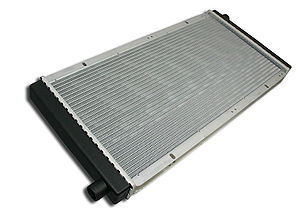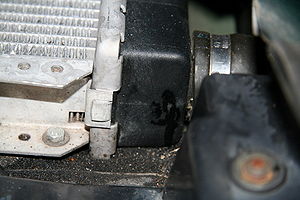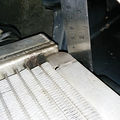Difference between revisions of "Radiator"
| Line 60: | Line 60: | ||
<gallery> | <gallery> | ||
| + | Image:Standard oem radiator.jpg|Standard OEM 32mm core, single row, single pass, with plastic end tanks | ||
Image:All aluminium hi pressure radiator.jpg|32mm core, single row, single pass | Image:All aluminium hi pressure radiator.jpg|32mm core, single row, single pass | ||
Image:ep_32_1row.jpg|Failing 32mm core, single row, single pass | Image:ep_32_1row.jpg|Failing 32mm core, single row, single pass | ||
| − | Image: | + | Image:es_42_srsp.jpg|42mm core, single row, single pass |
Image:pro_alloy_45_2row.jpg|Pro Alloy 45mm core, twin rwo, single pass | Image:pro_alloy_45_2row.jpg|Pro Alloy 45mm core, twin rwo, single pass | ||
</gallery> | </gallery> | ||
Revision as of 20:10, 1 September 2014
The standard OEM Elise radiator is another weak point in the cooling system. Although it is lightweight, it has plastic end tanks which are prone to expanding and leaking under pressure.
Unfortunately you need to Remove S2 front clamshell before you can replace the radiator.
A upgraded radiator is pretty advisable when going for Honda/Audi/Duratec engine upgrades. Most converted cars on the original radiators seem to blow them up pretty soon after conversion.
Leaks
The most common fault with the OEM radiator is cracking/spliting of the plastic end tanks. The first signs of failure are drops of coolent on the windscreen, either drivers or passengers side, but castrophic failure of the end tanks has been known.
Quite often the passenger side hose is poorly connected (because it is difficult to do) and sometimes the bleed screw can leak.
The OEM radiators seem to have a problem with their manufacture where the main core is bonded to the top/bottom and leaks are all too common.
Indication of HGF
Its been suggested in the past that a blown radiator can indicate imminent HGF. The header tank cap is normally the first to vent when the system is pressurised since it only requires approximately 1 bar. The radiator is designed to operate at pressures a lot higher than this and the cap acts as a fuse. However, the header tank is on the lowest pressure point of the circuit and this allows high pressure peaks on the high pressure side (which is from the engine to the rad). Therefore it would be prudent to have a petrochemical test (sniff test) performed on the coolant fluid if the radiator fails to rule out possible HGF.
Aftermarket Upgrades
There are basically three options available when it comes to after market radiators that will fit an Elise/Exige. All three are 'all aluminium' and none have the dreaded plastic end tanks. There appears to be only two manufacturers that are making these radiators. The 42mm single row is made by ??? and the 45mm twin row single pass is made by Pro Alloy. All on-line retailers sell the same radiators, they just badge them with different names to confuse you. Hopefully the following table will help when making your choice for purchase:
| On-line Retailer |
32mm Core/Single Row Manufactured by ??? |
42mm Core/Single Row Manufactured by ??? |
45mm Core/Twin Row Manufactured by Pro Alloy |
|---|---|---|---|
| Eliseparts | ALUMINIUM HIGH PRESSURE RADIATOR | Not available | ALUMINIUM UPGRADED RADIATOR |
| Eliseshop | Not available | Aluminium High Pressure extra capacity Radiator | Pro Alloy Full Aluminium Race Radiator |
| Pro Alloy | Not applicable | Not applicable | Alloy Race Radiator |
| Hangar 111 | Not available | PERFORMANCE RADIATOR - 42MM CORE | TRACK DAY/MOTORSPORT RADIATOR - 45MM CORE |
| Seriously Lotus | Radiator High Pressure 32mm | Radiator High Pressure 42mm | Not available |
The radiator fitted by Lotus with the plastic end caps is a 32mm single core, single pass, manufactured by PMA Group. The direct replacement for this radiator, maintaining the same coolant volume in the system, is in column one. Columns two and three offer greater capacity. Other variations are available but the above three will cater for 99.9% of people on road and trackdays.
The following video will help you understand some of the terms used in radiator speak, like twin rows, dual cores, triple pass etc:
Triple Pass
The triple pass radiators are only intended for motorsports and are not recommended for road use. The reason being there is not enough coolant flow at idle (sitting in traffic) to force the coolant through three passes of the radiator. Road users who have fitted triple-pass radiators have resulted in increased engine temps. This advice holds for heavy trackday heros that drive their cars to/from circuit; the car is still liable to be stationary in traffic.
| On-line Retailer |
42mm Core/Single Row/Triple Pass Manufactured by ??? |
45mm Core/Twin Row/Triple Pass Manufactured by Pro Alloy |
50mm Core/Twin Row/Triple Pass Manufactured by ??? |
|---|---|---|---|
| Eliseparts | Not available | TRIPLE PASS RADIATOR | Not available |
| Eliseshop | Aluminium Triple Pass RACE Radiator | Not available | Not available |
| Pro Alloy | Not available | 3 Pass Race Radiator | Not available |
| Hangar 111 | Not available | TRIPLE-PASS MOTORSPORT RADIATOR - 45MM TWIN ROW | Not available |
| Seriously Lotus | Radiator Triple Pass 42mm | Pro-Alloy Radiator Triple Pass 45mm | Triple Pass Twin Core 50mm Race Radiator |






